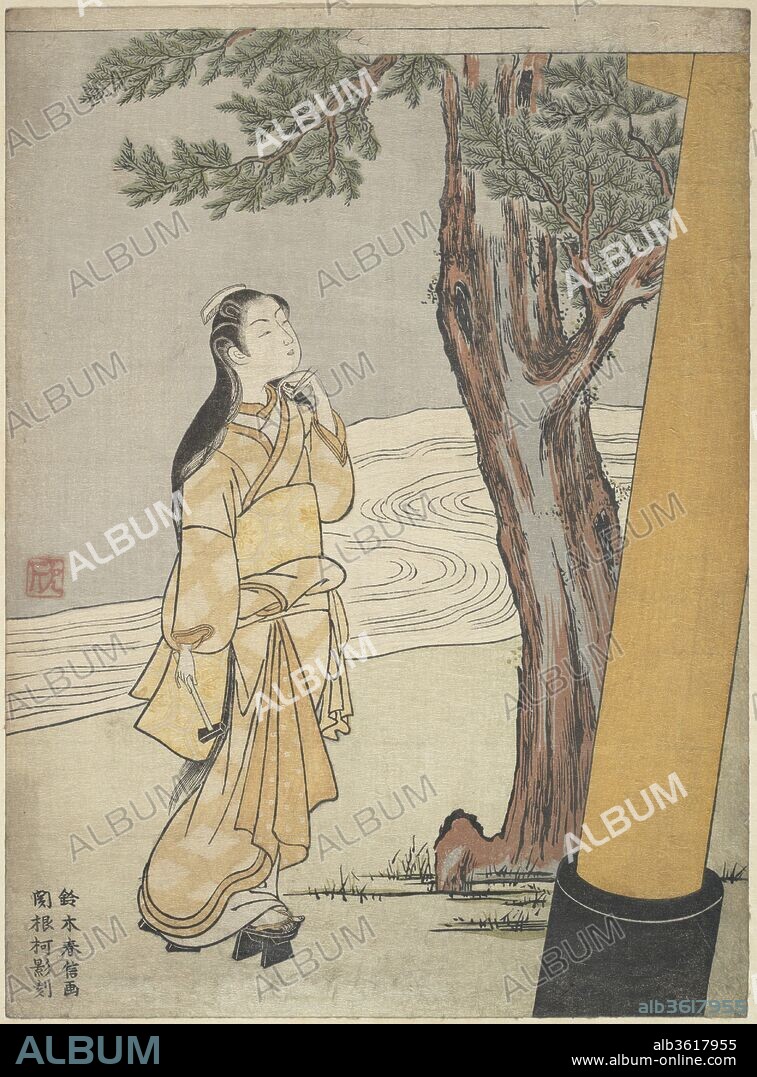alb3617955
SUZUKI HARUNOBU. Visit to a Shrine at the Hour of the Ox (Ushi no toki mairi)

|
Añadir a otro lightbox |
|
Añadir a otro lightbox |



¿Ya tienes cuenta? Iniciar sesión
¿No tienes cuenta? Regístrate
Compra esta imagen.
Selecciona el uso:

Autor:
Título:
Visit to a Shrine at the Hour of the Ox (Ushi no toki mairi)
Descripción:
Traducción automática: Visita a un santuario durante la hora del buey (Ushi no toki mairi). Artista: Suzuki Harunobu (japonés, 1725-1770). Cultura: Japón. Dimensiones: 28,3 x 20,6 cm (11 1/8 x 8 1/8 pulgadas) impresión de tamaño mediano (chu-ban). Fecha: 1765. En sus manos, la mujer lleva clavos y un martillo para clavarlos en un árbol y lanzar una maldición. Conocida como ushi no toki mairi (visita durante la hora del buey), la maldición se lanza en la oscuridad de la noche (la hora del buey es alrededor de las 2 a. m.) y está destinada a fastidiar a un amante infiel o a un rival exitoso. Por lo general, se clavaba una efigie de paja en un árbol cerca de un santuario y se cantaban maldiciones apropiadas durante el acto. Harunobu ha omitido la efigie y la mujer no lleva la corona de hierro con tres velas que se usaba normalmente en la ocasión. Tampoco parece estar maldiciendo. En cambio, parece casi como si estuviera soñando, tal vez con una dulce venganza. Se trata de un calendario ilustrado (e-goyomi) del año 1765. Como se muestra en el diagrama siguiente, los meses dai y sho de ese año aparecen en las manchas claras del estampado del kimono de la mujer: los meses dai aparecen en la sección superior (algunos caracteres son ilegibles) y los meses sho en la sección inferior de su kimono. Como los números están grabados en relieve sin coloración, son extremadamente difíciles de leer. La estampa lleva el sello del comisionado, kin, en el lado izquierdo. Los nombres del tallador, Sekine Kaei, y del artista, Suzuki Harunobu, aparecen en la esquina inferior izquierda.
Visit to a Shrine at the Hour of the Ox (Ushi no toki mairi). Artist: Suzuki Harunobu (Japanese, 1725-1770). Culture: Japan. Dimensions: 11 1/8 x 8 1/8 in. (28.3 x 20.6 cm)
medium-size print (chu-ban). Date: 1765.
In her hands the woman carries nails and a hammer to drive them into a tree to set a curse. Known as the ushi no toki mairi (ox-hour visit), the curse is cast in the dead of night (the ox hour is around 2 a.m.) and is meant to spite either a faithless lover or a successful rival. Usually, a straw effigy was nailed to a tree near a shrine, and appropriate curses were chanted during the act. Harunobu has omitted the effigy, and the woman is not wearing the iron crown bearing three candles that was normally worn on the occasion. She also does not seem to be cursing. Instead, she looks almost as if dreaming, perhaps of sweet revenge.
This is a picture-calendar (e-goyomi) for the year 1765. As shown in the diagram below, the dai and sho months for that year appear in the light patches of the pattern on the woman's kimono: the dai months appear in the upper section (some characters are illegible) and the sho months in the lower section of her kimono. Because the numbers are embossed as relief without coloration, they are extremely difficult to read.
The print bears the commissioner's seal, kin, on the left side. The names of the carver, Sekine Kaei, and the artist, Suzuki Harunobu, appear in the lower left corner.
Técnica/material:
Polychrome woodblock print; ink and color on paper
Periodo:
Edo period (1615-1868)
Museo:
Metropolitan Museum of Art, New York, USA
Crédito:
Album / Metropolitan Museum of Art, NY
Autorizaciones:
Tamaño imagen:
3155 x 4270 px | 38.5 MB
Tamaño impresión:
26.7 x 36.2 cm | 10.5 x 14.2 in (300 dpi)
Palabras clave:
 Pinterest
Pinterest Twitter
Twitter Facebook
Facebook Copiar enlace
Copiar enlace Email
Email
